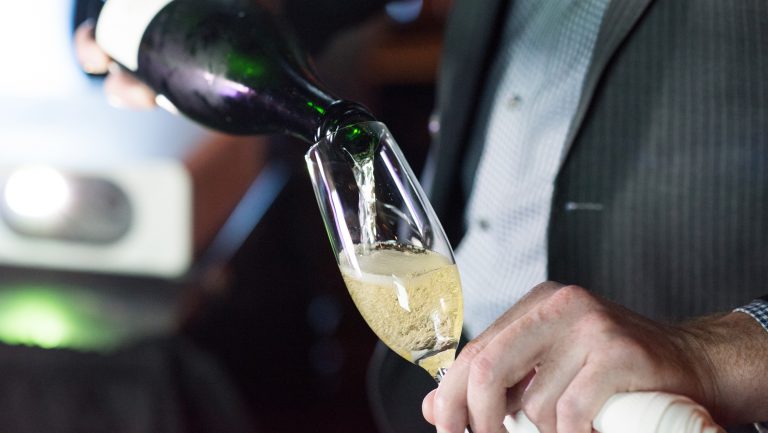This advertising content was produced in collaboration with our partner, Wines of Germany.
Traditional-method German Sekt has a high-acid profile, from the inclusion of aromatic varieties like Riesling, and entails high-quality production methods, such as secondary fermentation in the bottle and lees aging, both qualities which make it enormously appealing to any sparkling wine lover.
Germany, in fact, leads the world in sparkling wine consumption at four bottles per capita per year and it is also the third-largest producer after France and Italy, with 368 million bottles produced per year. The country’s fervor for fizz is increasingly focused on homegrown bubbles of such quality that they share the stage with other lauded global sparkling wines. For example, German Sekt b.A. (bestimmter Anbaugebiete), produced in one of 13 officially recognized regions, and Winzersekt (single-variety, estate-grown bottles) are amongst the top-tier in the category, which is growing in production, popularity, and exports.
SevenFifty Daily asked five Wines of Germany ambassadors to weigh in on why the excitement is bubbling over for German Sekt.

Don’t miss the latest drinks industry news and insights. Sign up for our award-winning newsletters and get insider intel, resources, and trends delivered to your inbox every week.
What makes Sekt such a compelling traditional-method sparkling wine?
Brent Kroll, proprietor and sommelier, Maxwell Park, Pop Fizz Bar, and Trouble Bird, Washington, D.C.
“Riesling is an incredible grape in the Champagne method. I love the stone fruit expression and high acidity, and it tends to have a juicy and round texture for pairing. I don’t think you can find anything else in the world that’s like a traditional method extra brut Riesling with over five years on the lees. There’s also a ton of diversity in the category. Look at something like Diel Sekt, whose current vintage on the market is 2009, but they also make wines aged up to 15 years on the lees. I’ve seen Peter Lauer from the 1990’s released into the market. Raumland is the legend of the bunch and I think even skeptics have to be in awe of what they do.”
How does Sekt evolve in the bottle?
Joe Kane, buyer, Waterford Wines & Spirits, Wisconsin
“Similar to most quality bubbles around the world, Sekt develops from a high-strung adolescent to a mellowed-out adult. The mousse softens and the tension lessens, but the acidity has a way of gently massaging the sides of the palate, then lays there like a lazy nap on the weekend. For Riesling Sekt specifically, it depends on aging and lees contact, but I find most of them won’t take on the aromas of autolysis like Chardonnay. On the nose, it can be slightly muted compared to still versions, but then it hits the palate with the intensity of a lightning strike.”
What are some of your favorite pairings for Sekt?
Amy Waller, sommelier, Khâluna, Minneapolis
“German Sekt adds depth and diversity to a wine list, offering an ace pairing option to any wine director or sommelier, especially those interested in exploration and pushing boundaries. I love turning guests on to how delightful and versatile sparkling Riesling can be. My favorite pairing is tartare of all kinds. The rich and salty dish begs for acid and bubbles to come through and refresh your palate. Sekt brightens the dish and accentuates whatever starch vessel (chips or bread) that comes with it. Secondly, a high-acid Riesling Sekt sings with the saltiness of oysters and is highlighted with a citrus mignonette. Crescendo!”
What trends are you seeing in Sekt?
Amanda Joffee, content creator, Florida
“I’ve seen an increase in excitement for Sekt made with Chardonnay, Pinot Blanc, Pinot Noir, Silvaner, and rosé bubbles made from Lemberger and Blaufränkisch, which all grow exceptionally in Germany’s cool climate. More producers are making Sekt with lower dosage—some are labeled naturherb—which are like brut nature Champagnes at a fraction of the cost. Winemakers are leaning towards estate-grown fruit and extended time on the lees. The organization Traditioneller Sektmachers is pushing for all wine labeled as Sekt to be made with local grapes in the traditional method, which makes sense as many other regions have a term exclusively for their traditional-method sparkling wine.”
What sets Sekt apart from other similar sparkling wines, like Champagne?
Marie Cheslik, founder and sommelier, Slik Wines, Chicago
“If you were to do blind tastings of high-quality Champagne to high-quality Sekts, professionals would have a hard time telling the difference. German sparkling has a leg up because the price point is still approachable, even for the best offerings. People are still paying for the Napa/Sonoma/Champagne real estate and perhaps German wine prices will catch up, but likely not any time soon. Much like Cru Beaujolais, we’ll be saying ‘I remember when Sekts cost twenty bucks.’ Enjoy it while you can! Do you like Champagne but want to try something more adventurous and off-the-beaten path? Try Sekt.”

Dispatch
Sign up for our award-winning newsletter
Don’t miss the latest drinks industry news and insights—delivered to your inbox every week.









